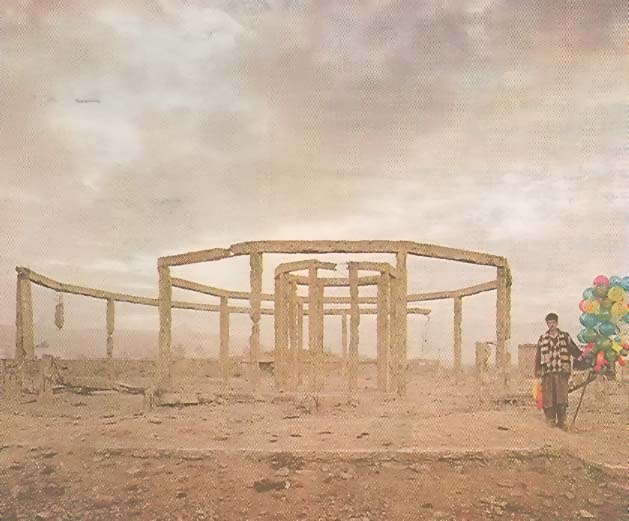 |
||
|
Romanticised Ruins of War
|
||
|
Suggestive and powerful, Nofolk's photographs reflect the shadows of war and its aftermath
By Christy Papadopoulou IN THESE digital times Simon Norfolk still works with an old-fashioned wooden - plate camera that needs a tripod and a black cloth over the photographer's head - the kind used by war photographers in the 19th century. His photos are not just straightforward photojournalist records of military conflicts in Afghanistan and Iraq. The 43-year-old, born in Lagos, Nigeria, steers clear of cliched shots of dilapidated buildings and mutilated bodies. |
 Simon Norfolk's photographic comment on the ephemeral |
|
|
His work is less explicit and reflects the shadows of war, be it in the form of instant settlements set up by refugees, the face of a young Aids victim in a country ravaged by civil war or the bizarre environments created by a global, computerised surveillance system known as Echelon. A playground for children shares the same frame with tanks, and a tank track resembles the spine of a monster fossilised in the earth; bathed in golden light, Normandy beaches carry no memories of the dawn attack of 6 June 1944 to slip into the comfortable guise of an idyllic holiday resort; a seemingly harmless icy landscape with a reddish pond in its centre is actually a waste dump for an aluminium plant but also a mass grave for hundreds of Bosnian men who were executed at its embankment; and in what could be interpreted as a discourse between timelessness and the ephemeral, a solitary balloon vendor poses with his bright merchandise (balloons were illegal under the Taliban) next to the ochre-dominated ruins of a concrete-building battered by war that reminds one of the archaeological site of Stonehedge. Norfolk, who gave up photojournalism in favour of landscapes, fashions his subjects to look like "archaeological treasures, the remains of a great civilisation" brought to its fall through war and its aftermath. "Walking a Kabul street can be like walking through a museum of war," points out the photographer, who is interested in ruins and their portrayal in art in the paintings of Nicolas Poussin and Claude Lorrain. The notion of the sublime - central to the movement of Romanticism - is conveyed in his work through the depiction of "what is beautiful and terrifying at the same time". Falling within the 13th Month of Photography events and held under the auspices of the British Council, Simon Norfolk's exhibition Et in Arcadia Ego runs at the Cats & Marbles Gallery (12 Fokylidou St, Komnaki, tel 210-3613942) till October 14. Open: Tuesday, Wednesday, Thursday and Friday 1O.30am3.30pm and 5.30pm-8.30pm; Saturday llam-4pm |
||
|
|
||
(Posting date 24 October 2006)
All articles of Athens News appearing on HCS have been reprinted with permission. |
||
|
||
|
2000 © Hellenic Communication Service, L.L.C. All Rights Reserved. http://www.HellenicComServe.com |
||

